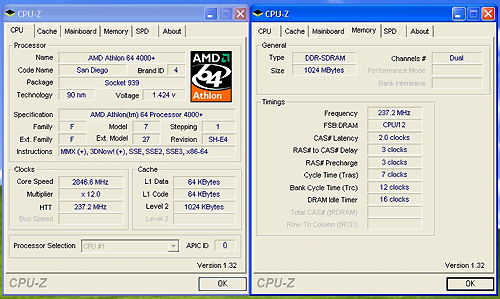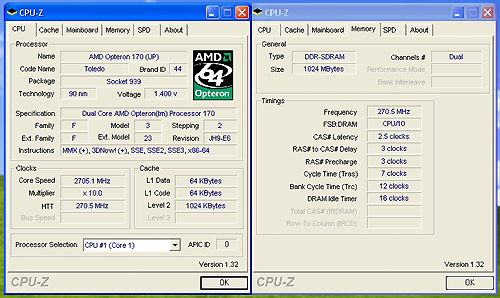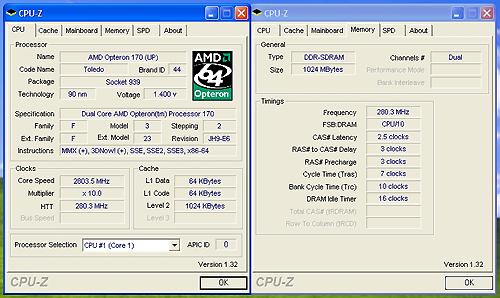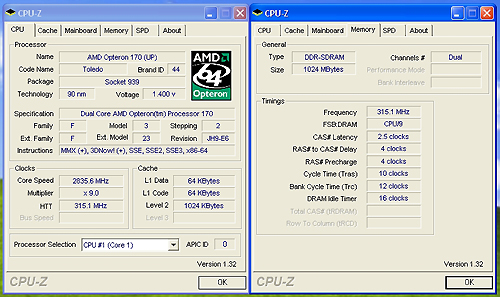ASRock 939SLI32-eSATA2: ULi Dual x16 SLI
by Gary Key on March 2, 2006 12:15 PM EST- Posted in
- Motherboards
FSB Overclocking Results
Memory Stress Testing
Memory stress tests look at the ability of the ASRock 939SLI32-eSATA2 to operate at the officially supported memory frequencies of DDR-400, at the best performing memory timings that the OCZ PC4800 Platinum Edition will support.
The ASRock 939SLI32 was extremely stable with 2 DDR modules in Dual-Channel mode at the settings of 2-2-2-5 at 2.7V. We will now install all four available memory slots that result in more strenuous requirements on the memory subsystem than testing 2 DDR modules on a motherboard.
The ASRock 939SLI32 was very stable with 4 DDR modules in Dual-Channel operation at the settings of 2-2-2-8, but required the command rate be increased to 2T that is typical in AMD Athlon 64 based systems.
| Front Side Bus Overclocking Testbed | |
| Processor: | AMD Athlon 64 4000+ (San Diego) AMD Opteron 170 (Toledo) |
| CPU Voltage: | 1.400V (1.300V default) |
| Memory Settings: | 2-2-2-5 1T - (12x) 2.5-3-3-7 1T - (10x) 2.5-4-4-10 1T - (9x) |
| Memory Voltage: | 2.8V |
| Chipset Voltage: | 2.1V |
| FSB Voltage: | 1.40V |
| HT Multiplier: | 5x up to 240HTT, 4x up to 315HTT |
| Memory: | OCZ PC4800 Platinum Edition |
| Cooling: | Thermaltake Big Typhoon |
| Power Supply: | OCZ Power Stream 520 |
| Maximum CPU OverClock (4000+): | 237HTT x 12 (2846MHz) +19% |
| Maximum HTT OverClock (4000+): | 315HTT x 9 (2835MHz) +57% |
| Maximum CPU OverClock (O170): | 270HTT x 10 (2700MHz) +35% |
| Maximum HTT OverClock (O170): | 315HTT x 9 (2835MHz) +57% |





Memory Stress Testing
Memory stress tests look at the ability of the ASRock 939SLI32-eSATA2 to operate at the officially supported memory frequencies of DDR-400, at the best performing memory timings that the OCZ PC4800 Platinum Edition will support.
| ASRock 939SLI32-eSATA2 Stable DDR-400 Timings - 2 DIMMs (2/4 slots populated - 1 Dual-Channel Bank) |
|
| Clock Speed: | 200MHz |
| CAS Latency: | 2 |
| RAS to CAS Delay: | 2 |
| RAS Precharge: | 2 |
| RAS Cycle Time: | 5 |
| Command Rate: | 1T |
| Voltage: | 2.7V |
The ASRock 939SLI32 was extremely stable with 2 DDR modules in Dual-Channel mode at the settings of 2-2-2-5 at 2.7V. We will now install all four available memory slots that result in more strenuous requirements on the memory subsystem than testing 2 DDR modules on a motherboard.
| ASRock 939SLI32-eSATA2 Stable DDR-400 Timings - 4 DIMMs (4/4 slots populated - 2 Dual-Channel Banks) |
|
| Clock Speed: | 200MHz (800FSB) |
| CAS Latency: | 2 |
| RAS to CAS Delay: | 2 |
| RAS Precharge: | 2 |
| RAS Cycle Time: | 8 |
| Command Rate: | 2T |
| Voltage: | 2.7V |
The ASRock 939SLI32 was very stable with 4 DDR modules in Dual-Channel operation at the settings of 2-2-2-8, but required the command rate be increased to 2T that is typical in AMD Athlon 64 based systems.










46 Comments
View All Comments
UJMA - Sunday, March 5, 2006 - link
I see, I'm still interested to see how this Epox board overclocks, I look forward to the Anantech review. If its priced similar to the Asrock Sli but with better voltage options I will get one despite it being x8 x8 ... thanks for the info.UJMA - Saturday, March 4, 2006 - link
fantastic!!! I rate Epox boards highly, I'm waiting for that particular board to make an appearance in the UK ... I look forward to your results!Redrider - Saturday, March 4, 2006 - link
I am looking to build a system for my 15 year old son who does video editing as his system stressing function, not gaming. We do video editing on my own aging but still quite nice FIC AU13max, Athlon2500+, All-in-Wonder 9700pro, 1GB (2x 512)PC2700, system that I built 3 years ago (my only other previous build). I want to build a system that will be good for video editing primarily but provide for gaming should his gaming interest change from his Playstation2 to his PC. I would build my own system and pass my old system down to him like I did last time, but really like the DVR/home theater I have set up with my TV, JVC 9010VBK receiver, and AIW AGP card.Anyway, things sure have changed since my last build! I could use a bit of guidance. I am considering this board and would like advice on the least expensive (as a baseline, I will work my way up from there budgetarily) CPU, memory, video card, etcetera that would serve the aforementioned needs.
To add a bit of complexity to my question (I hope this off topic diversion is ok) I had been considering a DFI LP UT NF4 Ultra-D mainly for the future potential if he gets into overclocking and such as well as the cool factor with a uv lighted case. Some reviews gave this poor marks for stability at the default settings which sent me looking elsewhere like here. Does the X2 support of the ASRock 939SLI32 warrant going with a dual core and this board for multitasking capability?
Thanks for your assistance.
dab - Saturday, March 4, 2006 - link
my $.02I just RMA'd a defective Ultra-D. The power requirements are very high, as it is capable of severely overvolting your hardware. It is also a very advanced board and may be difficult to use in many situations. Read at dfi-street.com before purchasing system components if you're serious about this avenue.
Perhaps he would be better off with a less demanding, more user friendly board like the Asrock board or an Asus offering.
Redrider - Saturday, March 4, 2006 - link
Thanks for the heads up. I was a bit apprehensive about the reviews referencing compatibility issues on the DFI. This ASRock seems interesting. Asus seems like people either love'm or hate'm. I tend away from mainstream as evidenced by my FIC Mobo which appears to be one of the last of the line. I guess I'll keep on looking to see what I come up with.If I go with the ASRock any component suggestions? Any other specific components that I should avoid?
Live - Friday, March 3, 2006 - link
Great to see the new way of presenting the gaming benchmarks. The "min" numbers are especially useful. Nice and easy to understand as well. Keep up the good work! I hope you will continue to use this in all your gaming benches. With the reports/speculation of Nvidias next high end offering being close to ATIs X1900XTX in the sense that it will beat it in some and loose in others this extra info might be the decisive factor.Missing Ghost - Thursday, March 2, 2006 - link
I don't like it. The layout is not very good. The chipset heatsinks look crappy. It seems like the southbridge heatsink is too high and will be in the way of expansion cards. And why a 20 pin power connector? I want 24 pins, especially because this board supports sli. I think I can find better for this price, but maybe that's because I don't care about 16x pcie slots.kelim - Thursday, March 2, 2006 - link
Can anyone confirm what (if any) Zalman HSFs are compatible with this motherboard?Gary Key - Friday, March 3, 2006 - link
Zalman CNPS-9500 - YesZalman CNPS-7700 - No
Zalman CNPS-7000 - I do not have this item but looking at the measurements it would be extremely close, taking the measurements off the 7700 unit in place it might fit but just as easily might not.
kelim - Saturday, March 4, 2006 - link
Thank you good sir. The 9500 is what I'll be coupling with this baby.